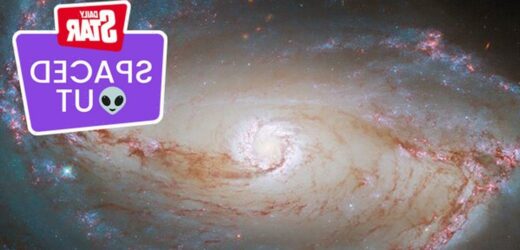Images from the Hubble Space Telescope have captured something remarkable from the depths of space.
The find, which is located 48 million light-years away from Earth, is unlike others that the telescope has made for one key reason: it's staring right back at us.
Hubble has been in a lonely orbit around the Earth since 1990, collecting vital research and progressing humanity’s understanding of the great beyond.
Some if its biggest discoveries include two moons of Pluto, comet impacts with Jupiter, the existence of supermassive black holes, and in 1995 took the breathtaking image of the Eagle Nebula, known as the ‘pillars of creation. This one, however, is a little different.
What did the Hubble telescope see?
Peering out through the gloom of space, the Hubble telescope saw an ‘eye’ staring back at it – a galaxy, much like our own, shaped exactly like the eye of a person.
The image is actually the heart, or ‘eye’, of a large galaxy called NGC 1097, a barred spiral galaxy that has been categorised in the same way as our very own Milky Way.
Officials from the European Space Agency (ESA), a partner of the Hubble project, said in a statement: "This picture reveals the intricacy of the web of stars and dust at NGC 1097's centre, with the long tendrils of dust picked out in a dark red hue."
In its statement, the ESA explained how the remarkable image was taken, saying the “galaxy’s structure is revealed… thanks to two instruments on the NASA/ESA Hubble Space Telescope: the Wide Field Camera 3 (WFC3) and the Advanced Camera for Surveys (ACS)”.
The two cameras allow the telescope to see in both infrared and visible light that the human eye can detect.
The image was composed "using seven different filters in total" using various instruments, before being colourised and released to the public.
Explaining how the image capture works, the ESA said: "A helpful starting point is to consider what colour is, exactly. Our eyes can detect light waves at optical wavelengths between roughly 380 and 750 nanometres, using three types of receptors, each of which is sensitive to just a slice of that range.
Ukraine's special forces trained by US to 'kill Russians' will fight on if war is lost
"Our brain interprets these specific wavelengths as colours. By contrast, a telescope camera like the WFC3 or ACS is sensitive to a single, broad range of wavelengths to maximise the amount of light collected. Raw images from telescopes are always in greyscale, only showing the amount of the light captured across all those wavelengths.
"Colour images from telescopes are indirectly possible, however, with the help of filters. By sliding a filter over the aperture of an instrument like the WFC3 or ACS, only light from a very specific wavelength range is let through — one such filter used in this image is for green light around 555 nanometres.
"This yields a greyscale image showing only the amount of light with that wavelength. This multicolour image of NGC 1097 is composed of images using seven different filters in total."
Has NGC 1097 been seen before?
Yes, astronomers have studied NGC 1097 before. In 2015 observations were made of molecular gasses around the galaxy’s centre point which allowed them to work out the size of its black hole.
The research found that it the mass of 140 million suns – an enormous contrast to the black hole at the centre of the Milky Way, which has a mass of about four million.
Source: Read Full Article






